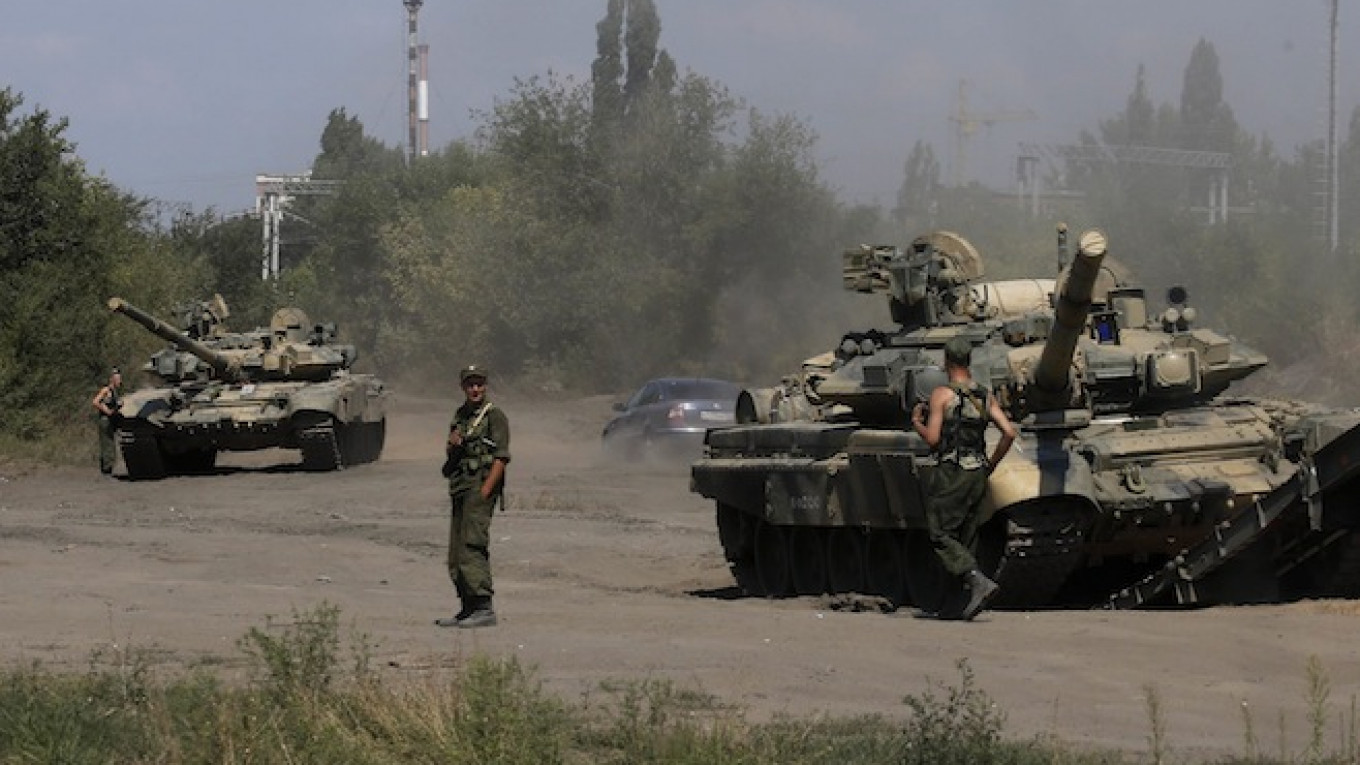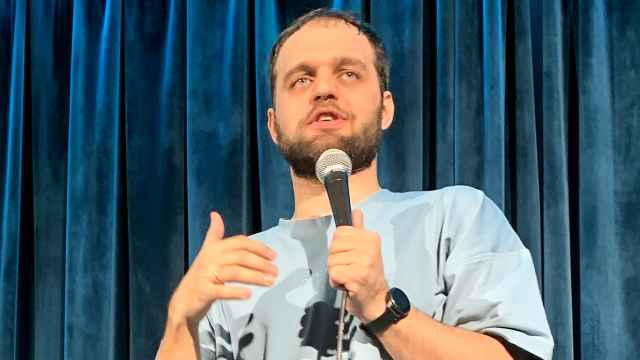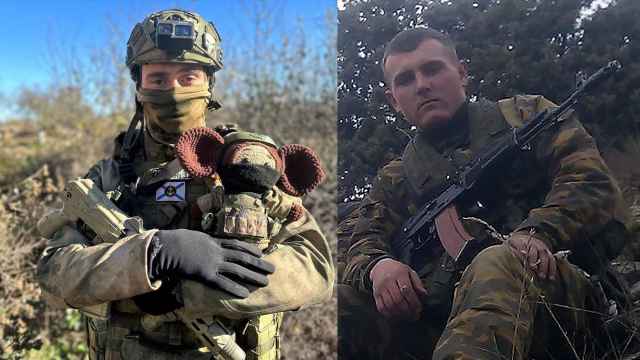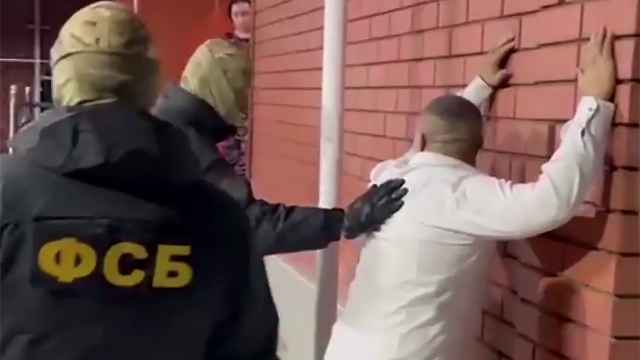On Monday, a resident of Novoazovsk in southeastern Ukraine said she saw a column of armored vehicles approach the town and start shooting.
"It all started at 8 this morning. Tanks appeared, no fewer than seven of them," the woman, who gave her name only as Lyudmila, told Reuters by telephone. "Right now I can hear rumbling, explosions. … The residents are hiding."
In Kiev later that morning, Ukrainian officials said the column was an incursion by Russian troops who it alleges are fighting alongside pro-Moscow separatists, a claim Russia quickly dismissed as disinformation.
That is a now-familiar ritual: the five-month conflict over eastern Ukraine is one of claim and counter-claim by opposing sides, often centering on what role Russia is playing. With the battlefield mostly too dangerous for reporters to safely move around, verifying who is doing what is usually impossible.
On Tuesday, in a continuation of the pattern, Kiev said it had captured a group of Russian soldiers who had entered Ukraine on a "special mission," while Moscow said they were there by mistake.
But the armored column that appeared on Monday in the far southeastern corner of Ukraine, where the country abuts the Russian border, was unusual because the spot was far removed from any territory held by the separatists.
It was therefore difficult to see how the column could have appeared in Ukraine without having come across the Russian border, unless it made an amphibious landing from the nearby Azov Sea — which is improbable given the number of heavy vehicles witnesses said they saw.
A Reuters reporter was able to observe the situation in the area where the column was seen, first at the start of August and then most recently on Sunday afternoon, a few hours before the first sightings of the column were reported.
Those observations, combined with interviews with rebel leaders, Ukrainian soldiers and other research, indicated two things.
First, that until late on Sunday there were no rebel formations within about 30 kilometers of the area where the armored column first appeared, and had not been for weeks beforehand.
And secondly, that before the armored column appeared, the area had come under artillery fire at times when the nearest rebel positions were beyond the range of most types of weaponry that could have delivered the strike.
It was not possible to establish whether the people driving the column and firing the artillery were Russian soldiers or separatist rebels. But there were strong indications that whoever was doing those things operated out of Russian territory — something very unlikely to have happened without Moscow's consent.
The question of Russian involvement is at the core of Western governments' response to the Ukraine crisis and could be crucial to how the conflict plays out.
The European Union and United States have already imposed sanctions on Russia in part based on allegations Moscow is arming the rebels. The West has warned of more sanctions if Russia provides further help.
Artillery Fire
A Ukrainian national guard unit stationed on the outskirts of Novoazovsk, on the road toward the Novoazovsk-Veselo-Voznesenka border crossing, showed a Reuters reporter a crater left by an exploding munition near their position.
They said the artillery fire was coming from over the border inside Russia, about 10 kilometers to the east.
"There were about 500 salvos from a Grad [multiple rocket system] and mortars. There have been and are no rebels here whatsoever. They're just firing straight from Russia," Roman, commander of a Ukrainian national guard unit, said on Sunday, before the armored column appeared in the same area.
Reuters saw no direct evidence of this, and Russian officials have repeatedly denied that their military is in any way involved in the conflict in eastern Ukraine, between pro-Moscow separatist rebels and government forces.
A spokesman for the Russian border guard service, when asked to comment, said: "This is stupid. Russia doesn't fire at anyone." The Russian Defense Ministry did not respond to a faxed request for comment.
But with no rebel presence within range inside Ukraine, it was not clear what other source there could have been for the artillery fire.
Even if rebels has somehow snuck into the area and fired the artillery, it seemed impossible they could have done that without using Russian territory to move about, given the distance from the nearest rebel-held locations.
Crater
The crater seen by the Reuters reporter on Sunday, before the clashes with rebels, was in the corner of a field behind a defensive trench dug by the Ukrainian national guard unit. A metal fragment that appeared to come from a munition was found in the hole.
Reuters showed the photographs of the crater to four European weapons experts who said the crater was either made by an artillery rocket, most probably a Grad, or by a shell from a self-propelled 122-mm gun.
According to one of the experts, Konrad Muzyka, a Europe and CIS armed forces analyst with consultancy IHS, the maximum range for the 2S1 Gvozdika, the Soviet-designed self-propelled 122-mm gun in use in ex-Soviet states, is 15.3 kilometers. That is extendable to 21.9 kilometers when rocket-assisted projectiles are used, he said.
Muzyka said the maximum range for the most commonly used Grad rocket, designated as 9M22U, was 20.33 kilometers. He said other variants have ranges of up to 40 kilometers, but they are less widespread.
The rebels' self-proclaimed Donetsk People's Republic says its forces are pushing south from their main stronghold in the city Donetsk, but the settlements they said they had taken by Monday that were closest to the Novoazovsk-Veselo-Voznesenka crossing were Telmanovo, about 30 kilometers away as the crow flies, and Novokaterinovka, about 60 kilometers away.
That may have overstated the rebels' reach. A Reuters reporter who drove through Telmanovo twice on Sunday saw no sign of a rebel presence in or near the town.
One of the experts who reviewed the photographs, British-based independent weapons researcher Eliot Higgins, said he believed the crater was caused by a Grad rocket. He said the shape of the crater suggested the munition was fired from the northeast, the direction of the border with Russia.
The Ukrainian unit said most of the artillery struck in the area between their post and the border. Reuters was unable to inspect the other craters left behind by the strikes because of the risk the artillery fire could start up again.
Members of the unit said Russian artillery had been landing on the Ukrainian side overnight from Thursday to Friday, and again on Friday night.
On a previous visit to the area, on Aug. 1. Ukrainian border guards at the crossing point between Russia and Ukraine showed a Reuters reporter broken windows and holes in the roof of their building.
They said the damage was caused by mortar rounds fired from Russian territory. "There isn't a single insurgent around here for 50 kilometers," said one of the border guards, Artur Zakharov. "A mortar can travel six kilometers."
Asked by Reuters on Monday how the rebels could fire artillery so far from their positions, Andrei Purgin, DNR deputy prime minister, said: "In the conditions of modern warfare, 20 kilometers is no kind of distance for artillery."
"This is not a war of fronts. It's a civil war. Movements of troops can take place here practically instantaneously. All of us here are insurgents. You come home, you grab your weapons, and you go out and shoot."
A Message from The Moscow Times:
Dear readers,
We are facing unprecedented challenges. Russia's Prosecutor General's Office has designated The Moscow Times as an "undesirable" organization, criminalizing our work and putting our staff at risk of prosecution. This follows our earlier unjust labeling as a "foreign agent."
These actions are direct attempts to silence independent journalism in Russia. The authorities claim our work "discredits the decisions of the Russian leadership." We see things differently: we strive to provide accurate, unbiased reporting on Russia.
We, the journalists of The Moscow Times, refuse to be silenced. But to continue our work, we need your help.
Your support, no matter how small, makes a world of difference. If you can, please support us monthly starting from just $2. It's quick to set up, and every contribution makes a significant impact.
By supporting The Moscow Times, you're defending open, independent journalism in the face of repression. Thank you for standing with us.
Remind me later.






